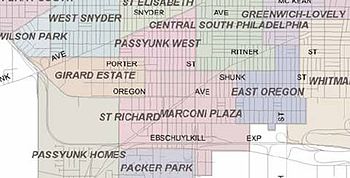Marconi Plaza
The plaza was named to recognize the 20th-century cultural identity in Philadelphia of the surrounding Italian American enclave neighborhood and became the designation location of the annual Columbus Day Parade.The east and west plaza reflected the same winding pathways, leading to a raised stepped terrace surrounded by stone railings and entrance sculptures of large urns, with two small "reflecting" pools of water facing Broad Street at the center point, which at that time was cut away from the curbline, forming half circles open to traffic on both the east and west.Over the years, many of the fine details have been erased, including the half circled indented curbline on either side of Broad Street at the center.The pools were filled in to provide the foundation for the two statues that were later erected to support the cultural history of the immigrant Italian community and respond to Anti-Italianism.[citation needed] It was purchased for $18,000 with money raised by Italian-Americans and the Columbus Monument Association, through the efforts of Alonzo Viti of Philadelphia and his brothers.[4] During the aftermath of the George Floyd protests and greater Black Lives Matter (BLM) movement in June, statues depicting Christopher Columbus as well as other historical figures had become a target for vandalism and city sanctioned removal nationwide.[5] On June 15 conservative WPHT radio talk show host Dom Giordano interviewed a South Philadelphia resident who defended the statue in a segment called "The 'Gravy Seals' Speak Out".[8][9] On June 24 it was announced the city would request permission from the Philadelphia Art Commission to remove the statue, with public feedback collected online and an official hearing set for July 22.[10] On August 12, the Philadelphia Art Commission issued an order to remove the statue from Marconi Plaza and to place it in temporary storage.





Urban parkPhiladelphiaPennsylvaniaOregon StationSouth PhiladelphiaItalian AmericanBroad StreetSports Complex Special Services DistrictLower MoyamensingBroad Street subwayMoyamensing BlvdPaul Philippe CretOlmsted BrothersSesquicentennial ExpositionSouthern Boulevard ParkwayLeague Island ParkFairmount ParkGuglielmo MarconiF. Amadee Bregy SchoolNational Register of Historic PlacesterraceRoman gardensEnglish gardensAnti-ItalianismMarble Statue of Christopher ColumbusChristopher ColumbusCentennial ExpositionGeorge FloydBlack Lives MatterItalian-AmericanJim KenneyTwitterthe paradecounter-protestersPhiladelphia Historical CommissionGeorge Floyd protestsStatue of Christopher Columbus (Philadelphia)George Floyd protests in PhiladelphiaHistory of Italian Americans in PhiladelphiaList of monument and memorial controversies in the United StatesList of monuments and memorials removed during the George Floyd protestsGreco-RomanBenjamin Franklin ParkwaySports Complex Special Service DistrictList of parks in PhiladelphiaNational Park ServiceYouTubeSections andneighborhoodsBella VistaCentral South PhiladelphiaDevil's PocketDickinson Square WestEast Passyunk CrossingFabric RowFDR ParkGirard EstateGraduate Hospital / Southwest Center CityGrays FerryHawthorneItalian MarketLittle SaigonMarconi PlazaMoyamensingNewboldPacker ParkPassyunk SquarePennsportPoint BreezeQueen VillageSchuylkillSouthwarkSports ComplexWest PassyunkWhartonWhitmanWilson ParkUniversal Audenried Charter HSCAPA HSFurness HSSouth Philadelphia HSUniversal Alcorn K–8F. Amadee Bregy K–8G. W. Childs K–8D. Newlin Fell K–8Andrew Jackson K–8Eliza Butler Kirkbride K–8Delaplaine McDaniel K–8William M. Meredith K–8George W. Nebinger K–8George Sharswood K–8Southwark K–8Edwin M. Stanton K–8Universal Vare K–8Vare-Washington K–8Francis Scott Key ESEx-Childs schoolDavid LandrethWilliam S. PeirceEx-Vare schoolSaints John Neumann and Maria Goretti Catholic HSSt. Anthony de Padua Parish2300 ArenaCitizens Bank ParkLincoln Financial FieldNew South Philadelphia ArenaWells Fargo CenterXfinity Live!John F. Kennedy StadiumSpectrumVeterans StadiumCongregation Shivtei Yeshuron-Ezras IsraelFranklin Hose Company No. 28Geno's SteaksGloria Dei (Old Swedes') ChurchGrays Road Recreation CenterLive! Casino & Hotel PhiladelphiaMarian Anderson HousePat's King of SteaksPhiladelphia, Wilmington and Baltimore Railroad Freight ShedRoyal TheaterSt. Anthony de Padua Parish SchoolSt Nicholas of Tolentine ChurchTindley Temple United Methodist ChurchTony Luke'sWalt Whitman BridgeMount Sinai Hospital